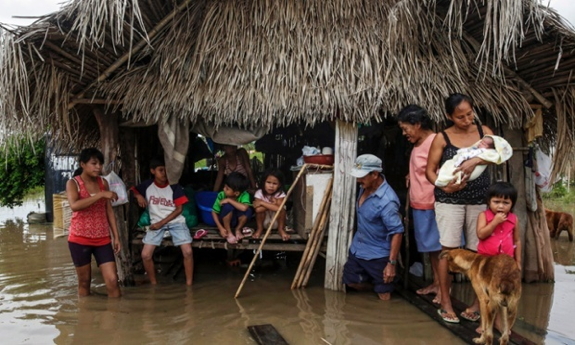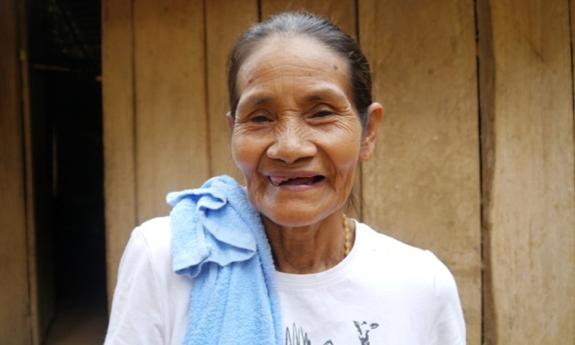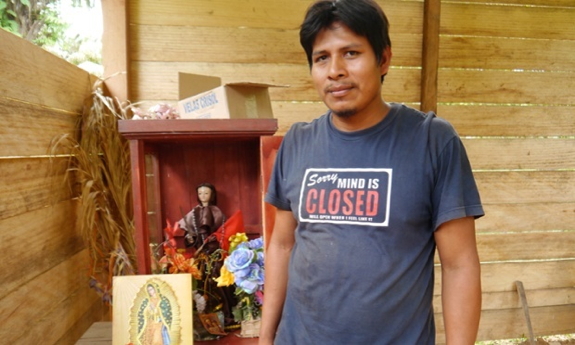
(above) Estela Parada, second from right, holds her newborn baby as she takes shelter with her family in the flooded Villa Marin quarter, on the outskirts of Trinidad in the Beni, Bolivia. Photograph: David Mercado/Reuters
Bolivia after the floods: 'the climate is changing; we are living that change'
December 8, 2014 - The Guardian
Bolivia's worst floods in 60 years submerged villages, ruined crops and destroyed homes. Some indigenous communities in the jungle are adapting to a more resilient way of living; others are forced out to the cities
by Sam Jones in Rurrenabaque
Nature used to give those who live along the river Beni fair warning of looming threats. If rings appeared around the sun, the leaves of the ambaibo tree twisted to reveal their white undersides or lines of ants began to march into people's houses, members of the indigenous Tacana nation took it as a sign that heavy rain was on the way.
But neither portents nor two months of ceaseless downpours prepared them for the deluge in northern Bolivia in February, drowning their livestock, ruining their crops, and sweeping vipers and anacondas through their half-submerged villages.
"Some people were saying it was the end of the world," says Wenceslao Mamio, the phlegmatic corregidor, or chief, of the Capaina community. "We were flooded as never before and left under a metre and a half of water. The waters killed our crops – bananas, cassava, pineapples, avocados, everything – as well as our pigs, ducks and chickens."
Those who could grabbed their children and animals and ran as the river burst its banks and its rain-swollen waters rushed 50m into their homes and fields. Not all of Capaina's 140 inhabitants, however, were quick enough.
Dilma Mamio Cartagena spent most of that day standing on a bench, shivering and praying. With the water rising and her ears filling with the cries of petrified children and animals, the 76-year-old watched her pots and pans float away as snakes slid around her.
(below) Dilma Mamio Cartagena, a member of the indigenous Tacana community of Capaina, narrowly survived the floods in February. Photograph: Sam Jones/Guardian

"I nearly died of sadness," she says. "I thought my life was over and I cried out to God, 'Please save me. Don't let the water come up any higher'. It rose up to my chest and I started to pray to San Gerardo, the patron saint of our village."
Her pleas were finally answered that night when Wenceslao swam to her rescue and took her to the school where the rest of the community was sheltering.
The ordeal was repeated across parts of northern and central Bolivia, where irregular La Niña and El Niño weather patterns caused the worst floods in 60 years, killing dozens of people and 150,000 cattle, destroying more than 43,000 hectares of cultivated land and affecting 60,000 families.
While the survivors have found themselves destitute, hungry, thirsty, and prone to fevers, infections and mosquito-borne diseases, the psychological damage has been equally acute.
"It hit the kids hard," says Wenceslao. "You didn't see them playing outside for a month because they were too scared."
The floods have also increased the Tacana's sense of isolation and abandonment. The indigenous nation, which has traditionally survived by fishing, farming and hunting caimans for their skin and meat, felt marginalised even before the disaster.
Nine months on, they wonder how and whether they will survive as a group.
Two hours' boat ride along the river is another Tacana settlement, Tres Hermanos. The flood damage there was so severe that, after living in cold mud and filthy water for a month, the community decided to leave behind their rotten huts and crops and move a mile deeper into the jungle.
"It was like living in a cave," says one villager as he recalls listening to the radio and wondering whether help from the government and Red Cross would reach Tres Hermanos.
For two families, the losses were too high and the help too late. Unable to support themselves in the village, they moved to the town of Rurrenabaque, where ferries and cruisers criss-cross the Beni and backpackers trade jungle adventures over cocktails and cold beers.
(below) Hernán Chipunabi, corregidor of Tres Hermanos, stands by a statue of the village's patron saint. He is trying to keep his community together in the aftermath of floods. Photograph: Sam Jones/Guardian

"They're selling things on the streets of Rurrenabaque now," says Tres Hermanos' 30-year-old corregidor, Hernán Chipunabi. "But they want to come back because it's calm and beautiful here. In the city if you can't find work, you don't eat."
The last few months, says Chipunabi, have been the hardest times of his seven years as corregidor. He has struggled to balance the needs of his pregnant wife and three children with those of the wider community, and despite the help of NGOs such as Practical Action and Christian Aid – which have provided 475 families in the flood-affected areas with resilient seeds, nutritional aid and risk management training – he believes only the government can guarantee his community's future.
"I grew up here, I live here and I want my children to grow up here," he says. "But we need water and electricity."
Taped to the wall of a freshly built hut in the new Tres Hermanos is an architect's drawing of a water pump tower that could one day give the villagers an alternative to river water polluted with chemicals and animal waste.
Like the saint's statue in the nearby glass case, the sprouting crops and the women learning to weave for market, the scheme allows them a little much-needed hope.
"The big problem is that these are very remote communities," says Victor Yapu, Bolivia representative for Soluciones Prácticas, the Latin American branch of Practical Action. "Some of them are 12 hours upriver and they live by fishing and hunting, which leaves them very dependent on the river and very vulnerable."
By working with the Tacana to improve farming methods, training them in flood preparedness and helping them access markets for their products, Yapu and his colleagues want to bring as much stability and resilience as possible to a community that sees itself as perennially forsaken. They are also co-ordinating their actions with five different government departments that are responsible for everything from civil defence to rural development and alternative energy.
Little by little, life in the communities is returning to its antediluvian rhythms. In Tres Hermanos, they are tending their rice crops and bagging up the peanut harvest. In Capaina, where today the Beni flows low, quiet and the colour of day-old tea, children play on swings made from caiman hides and show off the model they have made of their village. A banner across the top reads "Capaina, prepared for emergencies", while yellow signs on the maquette shows the quickest escape routes should the waters rise again.
Standing by the village football pitch, Wenceslao reflects on the worst events of his 51 years and offers his own simple explanation for the devastation: "I think the climate is changing and we are living that change."
And Dilma Maimo Cartagena still remembers the cold, the fear, and the skeletons of all the drowned peccaries, armadillos and jaguars that the forest gave up in the months after the flood.
She also still dreams of the floods, crying out in her sleep for someone to grab hold of her. "People say it will happen again but only God knows," she says. "I don't want to have to live through it again."